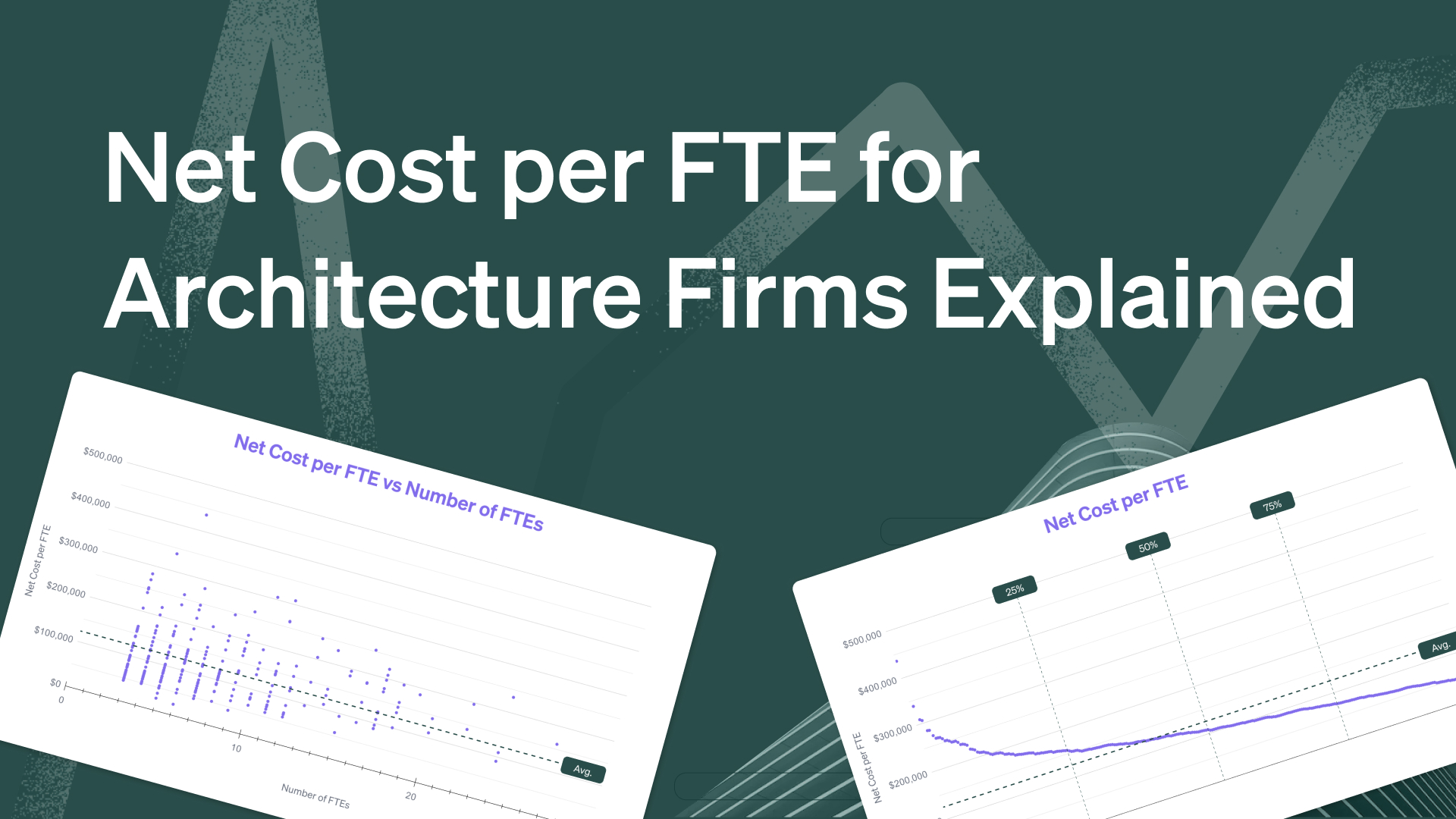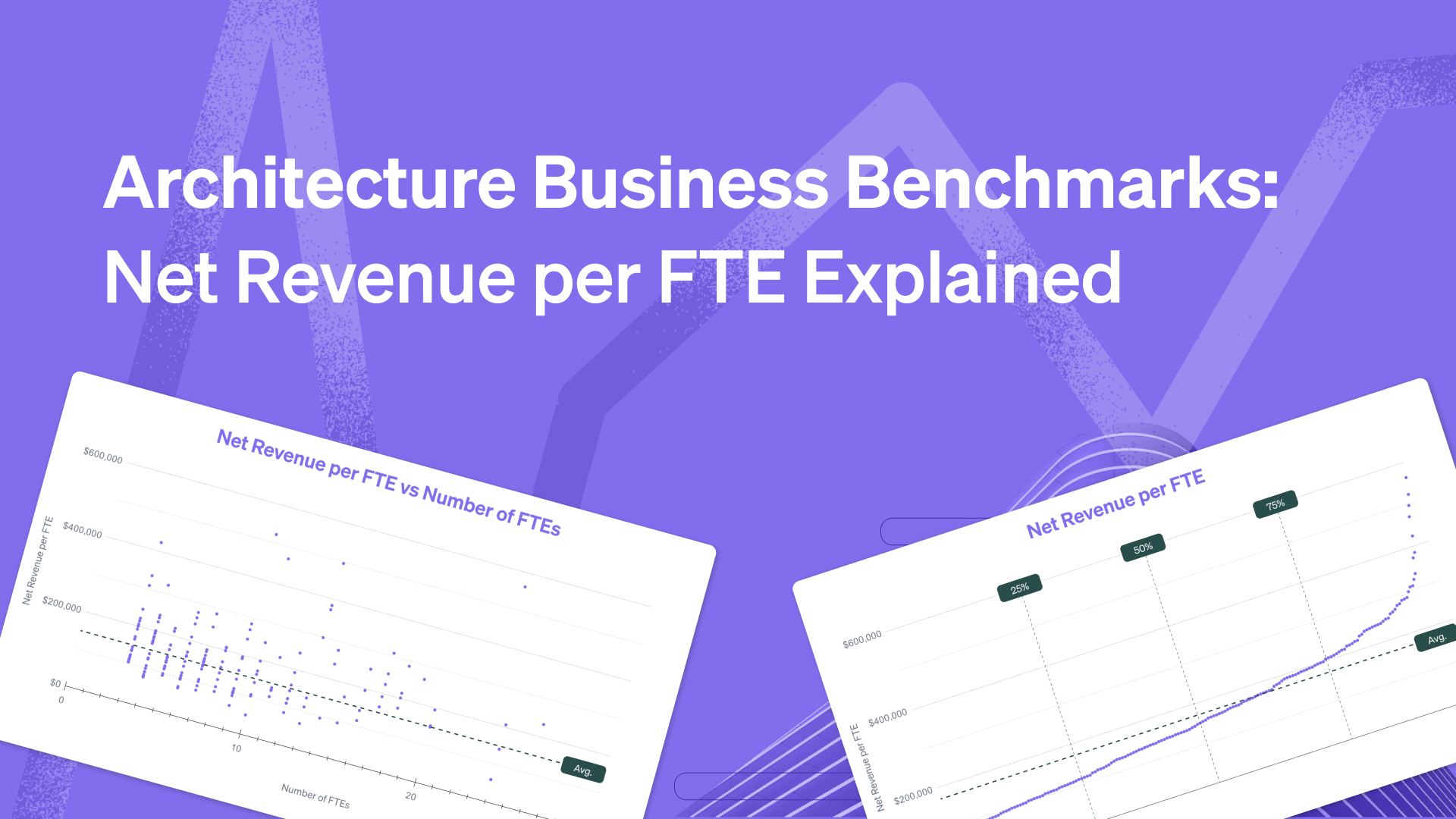Contents
Economic downturns are inevitable. But the problem is that we don’t always know when they’re coming.
While we can't control these fluctuations, we can prepare for them. How can architecture and engineering firms ensure they remain resilient during challenging times? Here’s the good news: there are A/E firms that manage to flourish despite economic conditions. Let's explore.
Monograph’s Risk Report
To uncover the best strategies, we spoke with top A/E industry leaders from firms like Olson Kundig, Marlon Blackwell Architects, Brooks + Scarpa, and many others. We compiled our learnings into a Risk Report to help A/E firms better manage economic risks. Their insights revolve around four primary risks:
- Client risk: Economic downturns can strain client relationships.
- Staff risk: Talent shortages can stifle growth.
- Time risk: Limited budgets mean doing more with less.
- Money risk: When inflation outpaces earnings, financial stability is threatened.
Here are the invaluable secrets these leaders generously shared.
Client Risk
01: Get face to face with your clients
“Go back to the basics for business development with informal, in-person networking like lunches and dinners to stay informed about how the economy could impact your clients and project pipeline.” - Hannah Brown, SHRM-SCP, Business Management Consultant, Brown Creative Consulting
Regular face-to-face interactions can lead to stronger client relationships, better understanding of client needs, and increased trust.
02: Prioritize your long-term reputation
“Be intentional about your business development and marketing. Invest in your long-term reputation with clients by avoiding the temptation to negotiate for short-term financial gain and by building relationships even before there is a project.” - Meryati Johari Blackwell AIA, ASID, LEED AP, Managing Principal, Marlon Blackwell Architects
Firms that prioritize long-term relationships often enjoy sustained client loyalty, leading to repeat business and referrals.
03: Put yourself in your client’s shoes
“Think like your client. Look outside your world for bigger issues that you can solve and find a way to help others. Building design is not just what a building looks like; it's what it is, how it operates, its context and community, and what it gives back to.” - Angela Brooks, FAIA, Managing Principal, Brooks + Scarpa Architects
By understanding and addressing broader community and environmental contexts, firms can offer solutions that resonate with clients and lead to more meaningful projects.
Key Takeaway: To navigate client risk, prioritize relationships over revenue.
Staff Risk
04: Help staff think like owners
“Develop a ‘Futures Council’ to focus on what’s next, including a wide group of people from a cross section of the firm, not just owners, with diverse points of view.” - Marjanne Pearson, CSO, Talentstar, Inc.
Firms that involve a diverse group in decision-making often benefit from a variety of perspectives, leading to innovative solutions and increased staff loyalty.
05: Develop a cadence of communication
“Get in the habit of daily, weekly, and monthly check-ins to see where your staff are in terms of mindset, how happy they are with their job, and what their ambitions are.” - Todd Reding, CEO, Charette Venture Group
Regular communication can lead to increased staff satisfaction, better alignment with company goals, and early identification of potential issues.
06: Focus mentorship on early career staff
“Nurture young graduates with 1-5 years experience by being more intentional about mentorship and cultivating a diverse talent pool.” - Kimberly Dowdell AIA, NOMAC, 2024 AIA President-elect, Principal, HOK
Intentional mentorship can lead to faster onboarding, increased job satisfaction among new employees, and a fresh influx of innovative ideas.
Key Takeaway: Effective communication and mentorship are the cornerstones of managing staff risk.
Time Risk
07: Use technology to increase efficiency
“Streamline the business side of your firm. Use QuickBooks and Monograph to get the low-hanging fruit done.” - Angela Brooks, FAIA, Managing Principal, Brooks + Scarpa Architects
Leveraging technology can lead to streamlined operations, reduced administrative burdens, and more time for core business activities. (Book a demo to see why 1,000+ A/E firms love using Monograph every day.)
08: Utilize historical data to inform future performance
“Use your past timesheets and billing data to write realistic proposals.” - Sarah Hughes, Director of Finance + Operations, Snow Kreilich Architects
Data-driven decision-making can lead to more accurate project budgets, better resource allocation, and improved client satisfaction.
09: Measure the impact of your time
“Track the investments you are making with clean and interconnected records about your projects, people, time, and money.” - Robert Yuen, CEO, Monograph
Accurate time tracking can lead to better project management, improved profitability, and more informed business decisions.
Key Takeaway: Time forms the foundation of everything we do. Use it wisely.
Money Risk
10: Review and respond to the impacts of inflation
“Adjust for inflation on an annual basis, not just in your rates, but also in your contracts. Include the potential need for additional services like value engineering because of the impact of inflation on construction costs.” - Sarah Hughes, Director of Finance + Operations, Snow Kreilich Architects
Adjusting for inflation can ensure consistent profitability and the ability to deliver projects without compromising on quality. Sarah Hughes and Robert Yuen dive deeper into cash flow management on the Business of Architecture podcast.
11: Forecast cash flow to anticipate future needs
“Shore up cash as much as possible. This will help firms weather uncertainty in the long run and in the short run.” - Hemanshu Parwani, "HP", Principal / Owner, CEO, Olson Kundig
Maintaining a healthy cash reserve can provide stability during economic downturns and the flexibility to pursue innovative opportunities.
12: Establish regular financial practices
“Track collections periods, follow up with clients, and proactively establish other periodic rhythms to reduce the time it takes to convert invoices to cash.” - Bolanle Williams-Olley, CFO, Mancini Duffy
Regular financial practices can lead to improved cash flow, reduced financial risks, and a more stable business foundation. Bolanle Williams-Olley and Robert Yuen talk more about mitigating economic uncertainty on The Second Studio podcast.
Key Takeaway: Financial foresight and discipline are essential for navigating money risks. Cash is confidence.
Make Your A/E Firm Recession-Proof
Economic downturns are challenging, but with the right strategies, A/E firms can not only survive but thrive. The overarching lesson from industry leaders is clear: proactive measures today can safeguard against reactive measures tomorrow.
If you want to learn more about building a resilient A/E firm then download our Free Risk Report!




